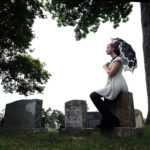Miranda Schnakenberg had planned to write a paper about a Gothic novel for an independent study. But she ended up shooting a movie and developing an entirely new passion.
The senior English major, who has a concentration in creative writing, admits she has lofty career goals as a writer. She aims to write “Everything! Novels, poetry, films . . . .”
At the same time, she always loved movies. So when she began work on her independent study with UMW English Professor Antonio Barrenechea, Schnakenberg took it more than a step further and created a film. Her goal: “go all in.”



Filmed in Alum Spring Park last April, the Confederate Cemetery and various locations around campus, the haunting film is based on an 1872 novel, “Carmilla,” one of the earliest examples of vampire fiction by Irish author Joseph Sheridan Le Fanu. “Carmilla” was one of the first works of its kind in the burgeoning genre of Gothic fiction. Schnakenberg enlisted several friends—theatre majors—to act in the film. Catherine O’Meara and Gwen Levey shined in the lead roles, and cameraman Alexander Rios “was instrumental in the process,” she said.
In Schnakenberg’s adaptation, the imagined Gothic past and modern-day realism are intertwined in a tale that’s both compelling and creepy, with a touch of the macabre thrown in. The distressed heroine arrives on a Virginia doorstep, she of pale face and dramatic mannerisms, asking for help from the 21st-century lady of the house. It’s not long before the viewer realizes that there’s something a bit, well, off about this heroine.
The screenplay took Schnakenberg almost 10 days to write, then nearly two weeks of filming and several days of editing. “You learn the most about filmmaking in the editing process,” she said. The final product—the 20-minute film—was shown during the Department of English, Linguistics and Communication’s Kemp Symposium last spring.
“I was impressed with the way she was bringing together things she’d learned across different courses to produce her adaptation of Carmilla,” said Kate Haffey, assistant professor of English. “This really represents the type of thinking that we want students to do in the liberal arts, making critical connections across different disciplines.”
Barrenechea agrees. “Hearing her talk about the process of adaptation, from page to screenplay, casting, photography, and editing, was fascinating.” He described Schnakenberg as a “star” at UMW, adding, “She’s one of the top five students I’ve had in the decade I’ve been teaching here.”
As well Schnakenberg has found a mentor in Barrenechea. While visiting family in Europe this past summer, she even carved out time to take a course he taught in Bath, England. The course was called “The Groovy Gothic: Frankenstein, Dracula, and the British Invasion.”
Schnakenberg’s newfound passion for filmmaking has inspired her to begin production of another movie. Spring boarding from a collection of her poems titled “Postcards from Astoria,” she will travel to the small fishing town of Astoria, Oregon. “It’s got a great sense of isolation and beauty.” There, she said, she’ll make a film to serve as a companion piece to the poetry.
With her 2017 graduation at UMW looming, has Schnakenberg set her sights on a filmmaking career?
Perhaps. But, first, she’s focused on her next role—as a graduate student pursuing a cross-disciplinary master of fine arts.
As for Schnakenberg’s fanciful film adaptation of “Carmilla,” she said, “I’ve never felt more alive.”
To view Schnakenberg’s film, visit https://www.youtube.com/watch?v=E1JjEzznWNs